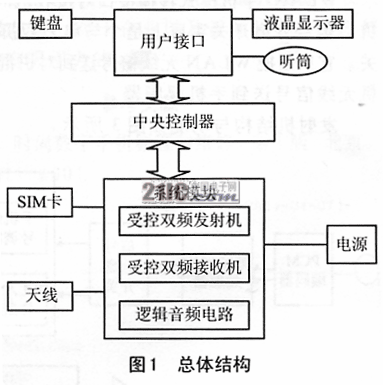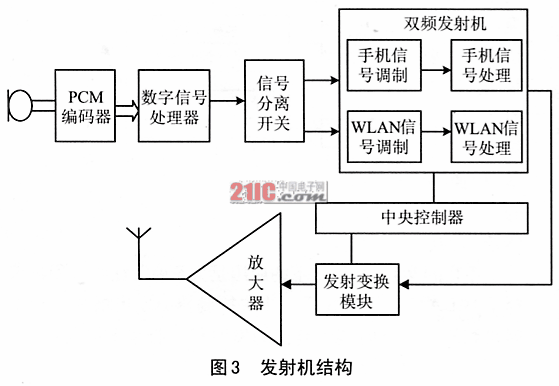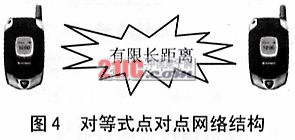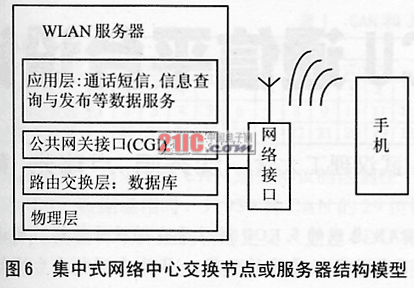Abstract: Starting with the new dual-mode structure of mobile phones, the principle of wireless local area network based on a small range of mobile phones under the original wireless local area network architecture is introduced. Without the need to go through the central switching network, realize internal call and short message service between members, and then set up a wireless WEB server through the internal server to realize internal data query and information release.
With the increasing development of electronics and network technologies, people's lives are more closely related to electronics and networks. Mobile phones and mobile communication networks, computers and computer networks, and the Internet have become an indispensable part of people's lives and work. Technically, wireless and high speed are the ultimate goals of the network; and from an economic perspective,  Cost and cost-effectiveness determine the vitality and market of a product. However, people can believe that a high-speed wireless network that can make people think it is reasonable and can meet most applications will inevitably cover every corner of the world. At that time, people could make video calls with anyone through their personal devices such as mobile phones and laptops, open video conferences, and order DVD movies online. This is the ultimate goal of our generation.
Cost and cost-effectiveness determine the vitality and market of a product. However, people can believe that a high-speed wireless network that can make people think it is reasonable and can meet most applications will inevitably cover every corner of the world. At that time, people could make video calls with anyone through their personal devices such as mobile phones and laptops, open video conferences, and order DVD movies online. This is the ultimate goal of our generation.
With the goal of faster speed, stronger functions, fewer wires, more convenient use, and simpler maintenance, the future communication system is developing in the direction of integration, broadband, and wireless. Integration is manifested in two aspects: one is the integration of mobile communication networks and computer networks; the other is the integration of multiple functions of the same network, such as calling, pheasant, and data. We have established a wired telephone network and a wired or wireless computer network within the enterprise. When this kind of network realizes the internal communication of the enterprise, since it does not need to pass through the central switching node of the network operator, the contact between the internal network and the outside world is reduced, and the security performance of the network is improved to some extent. Especially valuable is that it is completely free for internal communication. In recent years, with the development and maturity of WLAN (Wireless Local Area Wetwork) technology, new technologies and standards continue to emerge, such as IEEE802.11 (1Mb / s ~ 2Mb / s), IEEE802.11b (5.5Mb / s ~ 11Mb / s), IEEE802.a (10Mb / s ~ 25Mb / s), IEEE802.g (22Mb / s ~ 54Mb / s) and HiperLAN2, HomeRF and Bluetooth, the wireless local area network will surely decrease as its cost gradually decreases It has replaced the traditional wired network with its advantages of low comprehensive cost, easy maintenance, and simple installation, and has entered the enterprise department and thousands of households. At the same time, we have established an internal wired telephone network and a wired or wireless network of computers that do not need to go through the carrier-level switching center. With the increasing number of mobile phone users and the maturity of wireless computer network technology, an enterprise or department is established The time for your own mobile phone-based wireless LAN has arrived and is ripe.
The new unlimited local area network based on mobile phones only needs to add a software module to the original computer wireless local area network, and at the same time add a hardware module to the mobile phone. Such a long-term profitable investment plan with a small amount of investment is desirable and attractive for businesses and ordinary home users.
figure 2
1 New structure and functions of mobile phones
In order to adapt to new applications, a frequency adjustable module is added to the structure of traditional mobile phones. The function of this module is to enable the mobile phone to switch between WLAN / mobile phone mode through software (program setting) or hardware (add an ammonium button on the phone panel), and this switch is mainly to change the transmission and reception frequency and power to operate. The new overall structure is shown in Figure 1.
The application in the WLAN mode of the mobile phone is everyone's attention. After the user selects the WLAN working mode, the central controller will issue a command to allow the transmitter and receiver to adjust their transmit and receive frequencies and powers simultaneously, and then work in the WLAN mode.
The structure and function of the receiver are shown in Figure 2. The LAN (Low Noise Amplifier) ​​in the picture is the low noise amplifier. 
The antenna sends the sensed WLAN wireless signal to the receiver through the RF filter network. At this time, the WLAN / mobile phone mode conversion interface has been set by the central controller to the reception frequency of the intercom reception frequency, so the WLAN wireless signal passes directly. But because the frequency of the WLAN signal is different from the signal of the mobile phone, and the required mixer frequency is also different, the received WLAN wireless signal is passed through a signal separation switch to make the signal enter a different mixer. After mixing,  The signal is processed by the intermediate frequency filter, amplifier, demodulator, and then demodulated by the voice signal processor, deinterleaved, decrypted, channel decoded, PCM decoded, etc. The original analog signal is not sent out, and then sent to the receiver to sound.
The signal is processed by the intermediate frequency filter, amplifier, demodulator, and then demodulated by the voice signal processor, deinterleaved, decrypted, channel decoded, PCM decoded, etc. The original analog signal is not sent out, and then sent to the receiver to sound.
The WLAN / mobile phone mode conversion interface is a dual-frequency receiver for the receiver. The signal separation switch is essentially a switch similar to a single-pole double-throw switch. It just sends the WLAN wireless signal to the intercom mixer, or the mobile phone wireless signal to the mobile phone mixer.
The structure and function of the transmitter are shown in Figure 3.
After the microphone encodes the analog signal, it separates the signal through the separation switch. Then, the signal is modulated according to the command of the controller, and then transmitted after being transformed and amplified.
2 WLAN network design and programming
WLAN networks have distributed peer-to-peer networks and centralized networks.
(1) Distributed peer-to-peer network architecture and applications
According to different application methods, it can be divided into point-to-point interaction and point-to-multipoint interaction. Point-to-point interaction is shown in Figure 4. 
Users A and B enter WLAN mode within a limited distance. Enter the mobile phone number of the other party, you can achieve communication functions such as calling and SMS without going through the central switching node of the network operator.
Point-to-point applications: students in the field, train stations, airports, campus accommodation, family users.
The point-to-multipoint interaction structure is shown in Figure 5.
Point-to-multipoint interaction is guaranteed by the software / hardware of the mobile phone. Design a mobile phone broadcast number, just enter it directly during the broadcast. When necessary, you can set the answer password.
Point-to-multipoint interactive applications: industrial and agricultural production and other occasions that require close-range communication.
Extended application (extended applicaTIon): Distributed systems can also make a difference in the growing development of the service industry. For example, in an unfamiliar place, in order to find the nearest hotel, station, restaurant, etc., of course, you can use your mobile phone to connect to the WAN and pay a certain amount of money to find the required information. But if you provide an access number for each service, such as 001 for food, 002 for accommodation, 003 for the station, you can enter the WLAN mode, enter the access number, the other party will tell you how to find them by text or phone They delivered to the door. Of course, the phone is free, but the service is not free.
(2) Centralized network architecture and application
When the enterprise and his network become increasingly large, in order to provide more services and realize communication in a larger range, one or more central switching nodes or servers are required. The structure model of the centralized network center switching node or server is shown in Figure 6. 
Application layer (applicaTIon layer): uses the services provided by the common gateway interface layer, and uses a markup-based WML (Wireless Markup Language, wireless markup language) and a simplified JavaScript-based scripting language WMLScript (Wireless Markup Language Script), wireless mark Language script), to achieve simplified wireless WEB applications. At the same time provides the most basic call and short message (SMS, Short Message Service) and data query and release services.
Common Gateway Interface (CGI, Common Gateway Interface) layer: encode and compress the content on the server and perform protocol conversion to provide a programming interface for the application layer.
Router switch layer (router-switch layer): When the network becomes increasingly large, addressing by the mobile phone itself in a large area seems too complicated to achieve. At this time, the routing exchange addressing can be handed over to the server for implementation. This only requires the server to establish a database (database) and its related interface.
WLAN physical layer: the original WLAN facilities, such as switches and servers.
An application model of the centralized network is shown in Figure 7. In Figure 7, SAP (Service Access Point) is the service access point, and PDA (Personal Digital Assistance) is the personal digital assistant. The server is served by the PC. 
The network structure of departments 1 and 2 is relatively simple, and the access terminal only draws mobile phones. Of course, laptops and PDAs can also be accessed, but it only has a wireless local area network. The network of department 3 is more complicated. It accesses mobile phones, laptops and PDAs, and wired Ethernet (Ethernet) through a switch.
3 System reviews
The WLAN network itself has a simple structure, which can be maintained by ordinary personnel. The mobile phone-based WLAN network has the same simple structure and easy maintenance. At the same time, its internal communication is completely free, reducing the cost of the enterprise department, while wireless improves the efficiency of the enterprise department, indirectly reduces costs and increases profits. Such a long-term profitable investment plan with a small amount of investment is desirable and attractive for businesses and ordinary home users.
Street Legal Electric Car,Street Legal Electric Vehicle,Fastest Street Legal Electric Car,Electric Utility Vehicle Street Legal
Jinan Huajiang environmental protection and energy saving Technology Co., Ltd , https://www.hjnewenergy.com